I have been wanting to get to Hamburg for twelve years. The city has eluded me until just two weeks ago when I hopped on a train for the 250km (158 mile) trip from Berlin and made Hamburg the 171st city I have visited. This Northern Germany city is 610 miles (380 miles) from Munich and 365 km (227 miles) from Frankfurt.
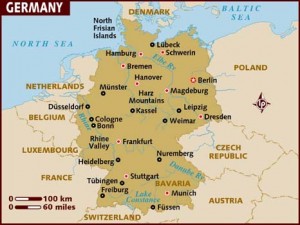
Aesthetics
Getting off the train in Hamburg, I was struck by two things. Firstly, how flat Hamburg is and secondly how much water the city has.
Officially, known as Free Harbour City of Hamburg, the city was founded at the mouth of the Alster river in the ninth century. It has been used as a port ever since. The River Alster flows south and joins the river Elbe in Hamburg. The river Elbe then flows into the North Sea, 110km from Hamburg. The Port of Hamburg on the river is the second busiest port in Europe. Interestingly, the The Free Harbor Status is unique as ships can come into Hamburg from anywhere and unload there without taxes being paid The Harbour is fascinating and I spent a morning running through it.
The city is known as The Greenest in Europe with 14 per cent of the city set aside for green space. In fact, Hamburg is building a green roof over one of their freeways.
At Hamburg’s heart are two stunning small artificial lakes. The lakes were formed on 1235 when the river Alster was dammed to power watermills. One is known as the Inner Alster (0.2 sq. kms). It is called “inner” because it was originally “inside” the original city walls.
The other lake is the Outer Alster Lake being outside the city walls. This lake is 1.6 sq. km in area. I ran the seven kilometres around the lake with many other Hamburgers enjoying the sun. Most of the lakeside is public space. There are stunning mansions around the lake which escaped the damage of world war two. To maintain the vista around the lake, I was told that the surrounding buildings have to be white with copper roofs.
The Inner Alster and Outer Alster lakes are separated by a single bridge, the Kennedy Bridge. From the Bridge one can look at the entire heart of the city. Canals link the rivers. There are more bridges than Venice and Amsterdam combined – over 2,500 in t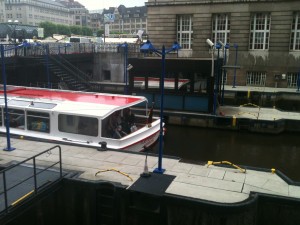 otal.
otal.
Weather wise, patterns and temperatures are influenced by both the North Sea and the Baltic Sea. I was surprised to learn that despite its northern proximity, snow is rare. June, July, and August temperatures are around 20 to 22 °C (68 to 72 °F). December, January, and February temperatures sit around 0 and -1 (29 to 32 °F).
The built environment owes a lot to World War Two. Being a port city, Hamburg was very heavily bombed by the allies. In the last week of July, 1943, the RAF and USAAF rolled out Operation Gomorrah, a bombing raid which killed 42,600 people, left 37,000 wounded and caused some one million German civilians to flee the city. The raid created one of the worst firestorms of World War Two and basically destroyed all of Hamburg. Hamburg surrendered to the British Forces on 3rd May 1945. Today, there are some traditional 19th century buildings which survived along with many rebuilt structures and new , along with many newer structures.
Liveability
Home to over 1.8 million people, Hamburg is the second largest city in Germany and the sixth largest city in the European Union. It’s area is seven times that of Paris (Pop: 2.2m) and twice that of London so living space is quite generous by European standards. Hamburg ranked 16th in the world for liveability in 2011 and, in 2010, the city ranked 10th in the world.
Culture
When I arrived in Hamburg, the streets were filled with people wearing 80s clothes. I had arrived in the midst of an 80s festival with parade and bands. It was hilarious watching people who were probably not born in the 80s wearing the crazy fashions and then there were other people who looked like they had just kept their old wardrobes! Hamburg is crammed full of Museums, Festivals, opera, theatre. More musicals are performed here than anywhere else in Germany.
The most notorious Hamburg attraction is the Reeperbahn the city’s red light district in the St. Pauli district and being a port city, you can imagine how big this is. Reeperbahn means ropewalk, which is a place where ropes are made. The area is also described in German as the sinful mile (die sündige Meile). Prostitution is legal in certain places and at certain times. I walked down Herbertstraße, a small side street which has a series of windows, similar to Amsterdam behind which prostitutes behind windows waiting for customers. Unlike Amsterdam, however, the entrance to the street is blocked with signs stating women and young people cannot enter.
Being so near the water, food in Hamburg features seafood a lot. Hamburg dishes include “Birnen, Bohnen und Speck” (green runner beans cooked with pears and bacon), “Aalsuppe” (eel soup), “Bratkartoffeln”, “Finkenwerder Scholle” (fried plaice) and Pannfisch (fried fish). My meal here cooked in a pan included potato, salad and prawns. The Hamburger was not nvented in Hamburg but was named after the city.
Crime and Safety
Despite the large number of people (albiet crazily dressed for the 80s Festival), the area around Central station felt a little dodgy. There were clearly drug affected people and prostitutes in broad daylight in the streets around. I was told it is the main centre of pickpocketing in Hamburg. Apart from that, hamburg felt very safe – even in Reeperbahn. Public transport felt fine. Apparently, 2011 was a record year for car fires in Hamburg.
Public Transport
One word: amazing. The Germans are poster children for superb public transit and Hamburg is no exception. In fact I would say Hamburg Transit is one of the top ten systems of the world. The HVV operate a combination of U-bahn, S-bahn, bus services and ferries (route map here). The fare zone is a little complicated but easy to get the hang of. HVV sell various ticket types including:
- Single Tickets (Einzelkarten)
- Day Tickets (Tageskarten) for 6.95 Euro. You can take up to three children with you on the same ticket which makes it amazing value. The best thing about the day ticket is that you can use it until 6am the next day. There is a Day Ticket which is cheaper (5.60Euro) and is valid after 0900 and is cheaper than two single tickets.
- The Hamburg Card which gives access to museums and attractions- one day is 8.90Euro and three days is 20.90. Using it at one museum immediately pays for itself
I bought my tickets from the multilingual machines. I never saw a ticket inspector.
Overall
On my city ranking, I give Hamburg an 8 out of ten.
The Hamburg Top Ten
- The two Alster Lakes (see above)
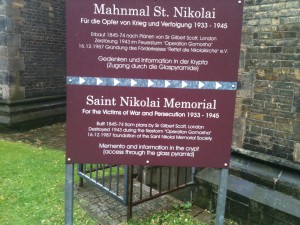
- St Nikolai Memorial – powerful display of the damage incurred by Hamburg in WW2 and an amazing city view
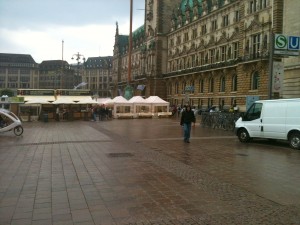
- Rathaus (100 year old Town Hall) and Rathausmarkt, the area around the Town Hall
- Harbour Promenade (Landungsbrücken) -very touristy (meal prices are much higher here) but well worth seeing
- Canal cruise (or even just a ferry ride)
- The Emigration Museum– five million Germans left the country between 1850 and 1939
- Historic Warehouse District
- Night on the Reeperbahn – you have to do it
- Fishmarkt -which I missed but everyone says is amazing
- Walking along the Elbe River to Blankenese, a cute village with thatched roofs (it is a 10km walk)


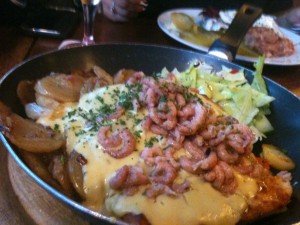


You might want to add a #11 on your list of things to see in Hamburg, Miniatur Wunderland, largest model railroad in the world. They’ve added a miniature airport, with model planes that take off and land even – http://www.miniatur-wunderland.com/
I didnt get to the Model. I would have loved to. Thank you for that tip. I love your reminder about mobile broadband. I have them for other countries but not for Germany.